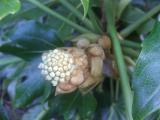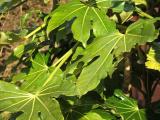

| November 2005 - Fatsia Japonica Though beautiful throughout the year, Fatsia is at its peak during the gloomy month of November. When other plants in the garden are settling down to a winter's rest, Fatsia suddenly produces panicles of white, slightly sweet-scented ivy-like flowers. These are much-prized by any late insects, providing them with a final sip of nectar. Those unfamiliar with this plant often think that it must be tender, judging by its glossy leaves and exotic appearance. It is, however, one of the toughest plants in the garden, happily shrugging off the frosts. |
 |
 |